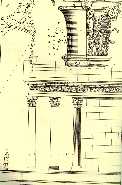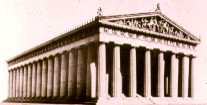Click to Enlarge
 Fig. 1 Corinthian Order from Palladio,
Bk. IV, Temple of Castor and Pollux, recommended by Jefferson for Capitol
Fig. 1 Corinthian Order from Palladio,
Bk. IV, Temple of Castor and Pollux, recommended by Jefferson for Capitol
The buildings of this period, dating roughly between 1820 and 1860, were
constructed from the architectural inspiration of Ancient Greece, but with
many touches that made them more distinctly American. In other words, they
were more than replicas of Greek buildings; rather they were American buildings
with Greek touches to them. For example, the Capitol Building of the United
States uses a Greek corinthian order, but replaces the icanthus leaf of
the authentic Greek capital with American maize or tobacco leaves (see.
Fig. 1-2)
| Slide
Gallery:
Click to Enlarge |
 Fig. 1 Corinthian Order from Palladio,
Bk. IV, Temple of Castor and Pollux, recommended by Jefferson for Capitol
Fig. 1 Corinthian Order from Palladio,
Bk. IV, Temple of Castor and Pollux, recommended by Jefferson for Capitol
|
| Slide
Gallery:
Click to Enlarge |

Fig. 3 - Second Bank of the USA, Philadelphia, Pennsylvania |

Fig. 4 - Parthenon, 5th Cent. BC, Athens, Greece |
|
|
|